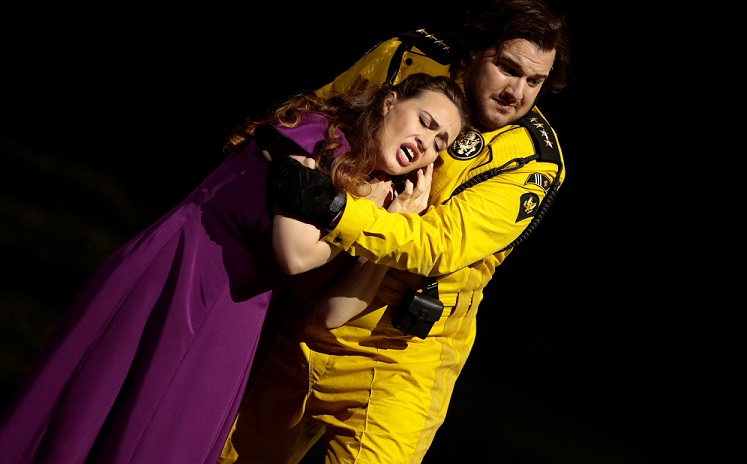 Switzerland Richard Strauss, Salome: Soloists, Chorus of the Zurich Opera, Philharmonia Zurich / Simone Young (conductor). Zurich Opera, Zurich. 12.9.2021. (JR)
Switzerland Richard Strauss, Salome: Soloists, Chorus of the Zurich Opera, Philharmonia Zurich / Simone Young (conductor). Zurich Opera, Zurich. 12.9.2021. (JR)

Production:
Director – Andreas Homoki
Set designer – Hartmut Meyer
Costumes – Mechthild Seipel
Choreography – Arturo Gama
Lighting – Franck Evin
Dramaturgy – Claus Spahn
Cast:
Herod – Wolfgang Ablinger-Sperrhacke
Herodias – Michaela Schuster
Salome – Elena Stikhina
Jochanaan – Kostas Smoriginas
Narraboth – Mauro Peter
Herodias’s Page – Siena Licht Miller
Jews – Iain Milne, Alejandro Del Angel, Martin Zysset, Andrew Owens, Stanislav Vorobyov and others
Nazarenes – Wilhelm Schwinghammer, Cheyne Davidson
Soldiers – Valeriy Murga, Alexander Fritze
A Cappadocian – Henri Bernard
Zurich Opera has launched its new season with a glorious new production of Salome, sung to a full house (we were all masked and our COVID certificates were checked on entry). The performance was also broadcast to a large audience in front of the opera house, basking with their picnics in the late summer sunshine. It was also streamed live for people to watch at home. It felt like the dawn of a new era.
It helped that this remarkable opera packs a veritable punch, the music is overwhelming, fine acting and singing adds to the heady mix and the storyline still shocks with its references – often visual – to decapitation, incest, sexual molestation, stoning and spearing.
Local Intendant Andreas Homoki has turned up trumps with this splendid new production; it resembles visually his modernistic production for Lady Macbeth of Mstensk but thankfully without the added references to genitalia. Homoki spotted, reading the libretto, that the moon is frequently referred to, so aptly a crescent moon forms the platform on which the singers sing, just above the cistern in which Jochanaan wiles away his time, with a ramp up to the (invisible) palace, stage left. Another crescent moon revolves on top of them, and a planet-like disc moves round the back wall from time to time. Homoki explains that his favourite set designer, Hartmut Meyer, does not build actual rooms but abstract spaces in which the singers can interact. It all works perfectly.
Homoki does take some liberties with the libretto, but, by and large, they work. When Narraboth stabs himself, his attentions spurned by Salome, Jochanaan steps forward and finishes him off by slitting his throat (yet this is the same Jochanaan who always thanks Narraboth for bringing him his daily meal). Jochanaan, once released from the cistern, is allowed to roam freely, he rejects Salome’s attentions but then wavers and proceeds to rape her (or is it consensual?); after that, one does wonder why Salome should be so hell-bent on merely kissing his (dead) lips. Right at the end, after Jochanaan has been beheaded, he reappears while Salome is musing on her lost love, but continues to ignore her. Was he a resurrection or simply in her dreams? Salome, who walks off slowly carrying Jochanaan’s head, is not killed on stage, but Herod hurls his command ‘Man töte dieses Weib’ as she exits.
The singers were all of the highest quality. We have to start with Salome, the impressive young Russian soprano Elena Stikhina. She has sung many title roles in all the major opera houses and is now clearly one of the leading sopranos of the moment, and deservedly so. She has sung the role of Salome at the Mariinsky and La Scala. She took a while to warm up, or perhaps just protecting her voice, but once she had overcome the volume of the orchestra (see below), she dominated the stage with her presence and her steely voice. Kostas Smoriginas, a Lithuanian bass, was resonant and had excellent stage presence. Mauro Peter is always a favourite in Zurich, and impressed, as ever. In the roles of Herod and Herodias, Wolfgang Ablinger-Sperrhacke and Michaela Schuster, who have sung these roles in Munich recently, were the perfect evil pair, with the clearest of diction; they could simply not be bettered.
Homoki noticed that Strauss had made a footnote to the effect that if more Jews were required, the producer need not be limited by 5; so Homoki added another 10. It added to the comedic effect as the Jews, ably led by firmly-voiced Scot Iain Milne, squabbled about whether Jochanaan was the first prophet to have seen God, or whether it had been Elijah, or whether it had simply been God’s shadow. Dressed in green suits, white shirts and ties, they looked like insurance salesmen. Salome sported a natty purple cocktail dress before being reduced to her nightdress after the ‘Dance of the Seven Veils’ (or petticoats in this production); Herod was in embroidered pyjamas and dressing gown, ready and willing to grope Salome at any moment; Herodias was dressed for the banquet, elegant in dark red ruche. The portly guards in yellow protective gear looked like a cross between the New York Fire Department and the Teletubbies.
In the pit Simone Young galvanised the orchestra into a tsunami of sound, the tuba to the fore. The players were clearly thrilled to be back in the pit again and made their presence felt, at times rather too much so. Some conductors are more sympathetic to the singers, but Young clearly wanted us to be overwhelmed with the luscious, often extraordinary sounds of the score. Some will have marked her down on this showing but one could not argue with the aural excitement. The applause at the final curtain was the loudest I have heard in Zurich for a very long time; I am sure partly because the audience was pleased to be back. But, as one critic put it to me succinctly after the performance, she was ‘over the moon’ with what she had just seen and heard.
John Rhodes
